
Crinoids are marine animals that make up the class Crinoidea, one of the classes of the phylum Echinodermata, which also includes the starfish, brittle stars, sea urchins and sea cucumbers. Those crinoids which, in their adult form, are attached to the sea bottom by a stalk are commonly called sea lilies, while the unstalked forms are called feather stars or comatulids, being members of the largest crinoid order, Comatulida.
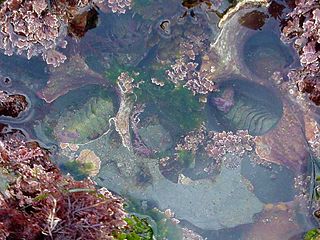
The Mesozoic marine revolution is the rapid adaption to shell-crushing (durophagous) and boring predation in benthic organisms throughout the Mesozoic era. The term was first coined by Geerat J. Vermeij, who based his work on that of Steven M. Stanley. While initially restricted to the Late Cretaceous, more recent studies have suggested that the beginning of this ecological arms race extends back into the Norian. It is an important transition between the Palaeozoic evolutionary fauna and the Cenozoic evolutionary fauna that occurred throughout the Mesozoic.

Comasteridae is a family of crinoids.
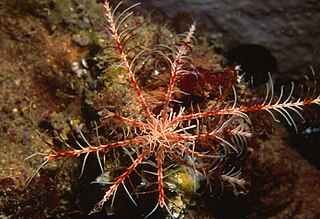
Antedon is a genus of free-swimming, stemless crinoids. The genus first appeared in the fossil record in the Cretaceous period.

Antedon bifida is a species of crinoid in the family Antedonidae commonly known as the rosy feather star. It is found in north west Europe.

Comatulida is an order of crinoids. Members of this order are known as feather stars and mostly do not have a stalk as adults. The oral surface with the mouth is facing upwards and is surrounded by five, often divided rays with feathery pinnules. Comatulids live on the seabed and on reefs in tropical and temperate waters.
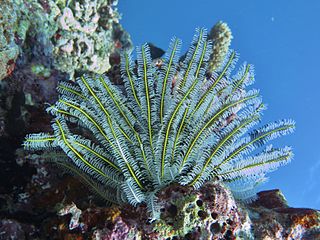
Comaster schlegelii, the variable bushy feather star, is a crinoid in the family Comasteridae. It was previously classified as Comanthina schlegeli but further research showed that it was better placed in the genus Comaster. It is found on shallow water reefs in the western Pacific Ocean.
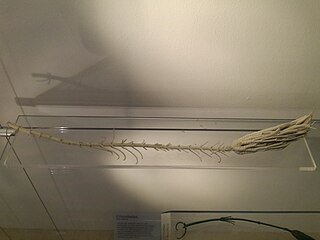
Metacrinus rotundus, the Japanese sea lily, is a marine invertebrate, a species of stalked crinoid in the family Isselicrinidae. It is a species found off the west coast of Japan, and is living near the edge of the continental shelf, around 100–150m deep. This is the shallowest species among the extant stalked crinoids.

Oxycomanthus bennetti, the Bennett's feather star, is a species of crinoid belonging to the family Comasteridae. It is found in shallow water in the Indo-Pacific between northern Australia and southeast Asia.

Antedon mediterranea is a species of stalkless crinoid in the family Antedonidae, commonly known as the Mediterranean feather star. It is found on the seabed at moderate depths in the Mediterranean Sea. It is a filter feeder and captures plankton with its long feathery arms.

Bourgueticrinida is an order of crinoids that typically live deep in the ocean. Members of this order are attached to the seabed by a slender stalk and are known as sea lilies. While other groups of crinoids flourished during the Permian, bourgueticrinids along with other extant orders did not appear until the Triassic, following a mass extinction event in which nearly all crinoids died out.
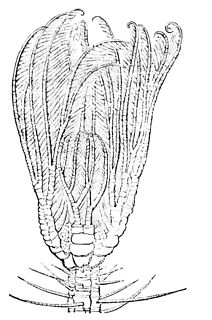
Cenocrinus is a monotypic genus of stalked crinoids in the family Isselicrinidae. The great West Indian sea lily is the only species in the genus and is found in deep waters in the Caribbean Sea and Gulf of Mexico.

Isocrinida is an order of sea lilies which contains four extant families.

Leptometra celtica is a marine invertebrate and species of crinoid or feather star of the Leptometra genus in the family Antedonidae. It is found in the Atlantic Ocean around the coasts of north west Europe. The presence of L. celtica and L. phalangium is considered to be a good indication of nearby shelf breaks, general bottom currents, and areas of high gross productivity as they are suspension-feeders, hence their proliferation in productive environments.
Paleontology or palaeontology is the study of prehistoric life forms on Earth through the examination of plant and animal fossils. This includes the study of body fossils, tracks (ichnites), burrows, cast-off parts, fossilised feces (coprolites), palynomorphs and chemical residues. Because humans have encountered fossils for millennia, paleontology has a long history both before and after becoming formalized as a science. This article records significant discoveries and events related to paleontology that occurred or were published in the year 2018.

Aporometra wilsoni is a marine invertebrate, a species of crinoid or feather star in the family Aporometridae. It is found in shallow water around the coasts of southern Australia.

Notocrinus virilis is a marine invertebrate, a species of crinoid or feather star in the family Notocrinidae. It is found in deep water in the Southern Ocean around the coasts of Antarctica and adjacent islands. A sea snail sometimes parasitizes it.

Aporometra paedophora is a marine invertebrate, a species of crinoid or feather star in the family Aporometridae. It was first found at a depth of 22 fathoms off the Manning River on the New South Wales coast. Other specimens were found off the coast of Bunbury, Western Australia at depths between 9 and 15 m. Based on morphological evidence of four specimens of A. paedophora, Helgen & Rouse believe that this may not be a separate species from Aporometra wilsoni.
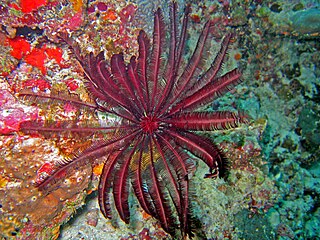
Cenometra bella is a species of crinoids belonging to the genus Cenometra. They can have up to 30 arms and can be of variable colours but are often characterised by a marked contrast between the extending free-arms and the feathery pinnules. This species clings to its support and moves around by its feet-like cirri.
Ailsa McGown Clark (1926-2014) was a British zoologist, who principally studied echinoderms and was a specialist on asteroidea. She worked at the Natural History Museum for most of her career.

















